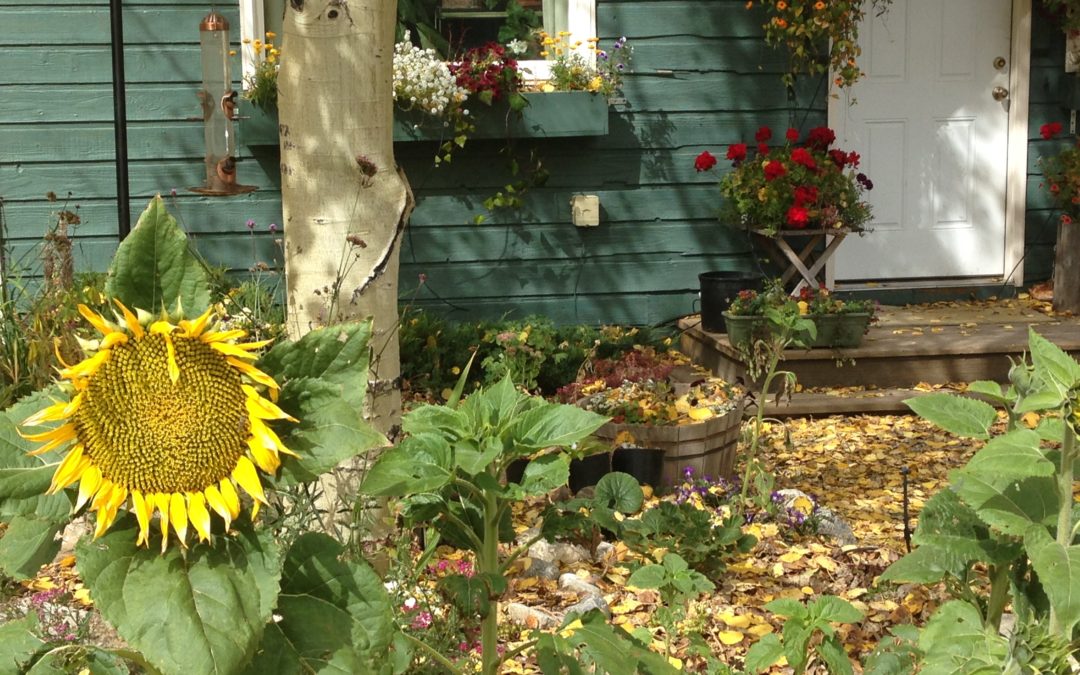What a winter! While the snow is still falling, now is the time to start thinking about creating your own personal mountain garden! The thought of growing anything in our unique environment can seem taxing for everyone, from the seasoned professional, to the dabbler with the brown thumb. Battling a short growing season, cold temperatures, rocky soil, and wildlife are just the tips of the iceberg.
I love and feel blessed to live in the small, community-driven area of Summit County, Colorado. Despite the challenges, starting a mountain garden can be achieved at any level or size. So while we start to put away our boards and skis, now is the time to come up with a rational plan for our personal growing spaces.
Use Containers/Raised Beds
Containers are great for small spaces such as condos, apartments, and decks. Containers are easy to find with several options and varieties available. Visit a thrift store and drill some drainage holes in just about anything. Cleanliness is key, especially when growing vegetables. Make sure to clean and sanitize containers first. One of my all-time favorite vegetable gardens in Summit County was a container garden on an east-facing deck in the Wildernest area. Involve your kids by allowing them to pick a small container and plant to take care of.
Raised beds provide good drainage, less soil compaction, fewer weeds, and minimal bending. Warmer soil temperatures in spring and fall allow for a longer growing season. Raised beds can be built with rot-resistant wood, rocks, or straw. Be creative: my raised bed is an old sandbox from a neighbor’s yard. Containers and beds should provide at least a 12-inch depth. When placing containers and raised beds, be aware of your sun exposure, water sources and irrigation options.
Another great option for people who lack a lot of space and are looking for a fun, educational, community-driven environment is one of the community garden plots in the county.
Visit https://www.highcountryconservation.org/community-gardens for a great resource to learn how to become involved in the local garden community.
Use Local Soil and Compost
The media you choose for your growing space is very important. We are blessed to have a great, affordable compost program offered by the High Country Conservation Center and the Summit County Landfill in Keystone. Local schools, restaurants, businesses, and contractors are able to bring compostable materials to the landfill. In return, compost is available to purchase to amend your garden with nutrients! You can purchase by the truckload, bring containers to fill, or purchase a burlap-filled bag. At this time deliveries from the landfill are not an option.
For new gardens (ground or container) I suggest a 70/30 or 50/50 blend of topsoil to locally made compost. For existing gardens, trees, shrubs, and flowers, I suggest adding 3 inches of direct compost to your growing area every season. The compost should be worked into the soil by shovel, rake, or hand tools to mix with the existing soil.
If bulk soil or compost is not an option, visit a local garden center or grow store to purchase quality topsoil or potting mixes. Alpine Earth Center and the Hydro Shack offer several bagged options for vegetable or flower growing. I do not suggest choosing medias with added nutrients, and suggest avoiding Miracle Grow products.
Start Small, Relax, and Have Fun!
When planning and starting your mountain garden, remember to come up with a realistic plan that you can commit to. While difficult to provide the entire family with all required vegetable servings all summer, supplementing your family’s lettuce and spinach intake is. Perhaps you over planted and are having trouble consuming everything you planted. Sharing your harvest with friends and neighbors is a great way to connect and possibly spread the gardening bug.
Maybe a couple flower containers on your deck provide you with a bright area to relax and recharge. Start small, get outside, and have fun with whatever you choose to grow.
Prepare to Plant
Choosing plants that enjoy the climate in Summit County is the next step. Stay tuned as we discuss local seed and plant options and planting tips specific to our area. We will also be discussing dealing with pests, specific care instructions like fertilizing and staking, and harvest tips throughout the summer.
Happy Growing,
Alyse
“The glory of gardening: hands in the dirt, head in the sun, heart with nature. To nurture a garden is to feed not just on the body, but on the soul,” Alfred Austen.

